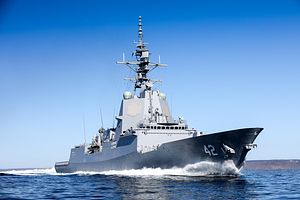The Royal Australian Navy’s (RAN) third and final air warfare destroyer (AWD), the future HMAS Sydney (DDG 42), has officially completed sea trials, the Australian Department of Defense (DoD) announced on November 9.
“Today’s milestone is another example of the Liberal and National Government’s successful initiative to reform the AWD program, setting the scene for the Naval Shipbuilding Plan,” Australian Minister for Defense, Senator Linda Reynolds, said in a press statement.
“Sydney will enter into service early next year, and with her sister-ships HMA Ships Hobart and Brisbane, they will be the most potent warships to date.
“By using a combination of Australian and globally proven technologies, these highly capable warships are truly world-class and will allow us to work even closer with our allies.”
Sydney completed two rounds of sea trials in September and October. The first round tested the warship’s hull, propulsion and navigation systems. The second round tested and evaluated the destroyer’s combat and communications systems.
The future HMAS Sydney will be the third and final ship of the 7,000-ton Hobart-class of guided-missile (air warfare) destroyers. The first-of-class HMAS Hobart was commissioned in September 2017. The HMAS Brisbane entered service in October 2018.
The warships are all based on the Navantia-designed Álvaro de Bazán-class frigate (aka F-100) currently in service with the Spanish Navy. The Hobart-class is the first class of Australian surface combatants to be built around the U.S.-made Aegis combat system and the first ships outside the U.S. Navy to be equipped with a cooperative engagement capability (CEC), a new wide-area integrated air defense system.
“CEC interfaces with the Aegis combat system and enhances its early detection capability,” I explained elsewhere. “It is a new wide-area integrated air defense system that allows the real-time sharing of sensor data on air targets, including incoming enemy aircraft and cruise missiles between CEC-equipped destroyers.”
The HMAS Brisbane conducted a CEC live missile engagement activity with the US Navy in October. “Using remote sensor data from the USS Stockdale and the Cooperative Engagement Capability, the combat system was tested against a range of challenging targets and tactical situations,” the Australian DoD said in a press statement on October 31.
The Sydney will be armed with a number of different weapons systems, as I wrote previously:
The armament of the HMAS Sydney will include the Mark 41 Vertical Launching System capable of firing surface-to-air missiles, Harpoon over-the-horizon anti-ship missiles, light-weight torpedoes, and a Mark 45 127-millimeter gun. The warship will also carry a MH-60R Seahawk anti-submarine warfare helicopter.
The Sydney was launched in May 2018 and will be delivered to the service in February 2020. Following the completion of sea trials, final production work includes the integration of the MH60-R helicopter.
The Hobart-class program is overseen by the AWD Alliance, a consortium that coordinates the work of Spanish ship maker Navantia, the Australian shipbuilder ASC, mission systems integrator Raytheon Australia, U.S. defense contractor Lockheed Martin, and the Australian Department of Defense.

































